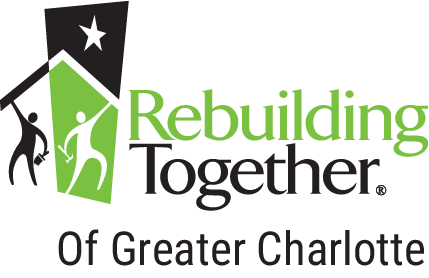Safe and Healthy Housing: Safe
A safe bathroom after repairs by Rebuilding Together of Greater Charlotte. It has a well-lit pathway, comfort height toilet, step-in shower, and grab bars.
A safe and healthy home is vital for overall health, which is why Rebuilding Together of Greater Charlotte’s Safe and Health Housing model is foundational for all the critical repair projects we do. The eight principles of a safe and healthy home are: clean, dry, ventilated, contaminant-free, maintained, thermally-controlled, pest-free, and safe.
Safe can be a loaded word. It has many different meanings to different people, but in the context of our homes, safe the feeling we’re chasing when we lay down our heads to sleep at night. So how can we ensure that our home is a secure environment to catch some Zs?
A Safe Home — From Top to Bottom
Starting from the top (literally), your roof is the main source of protection from any type of intrusion — from water, the sun, objects, insects, you name it!
A roofing problem often leads to critical repairs all around the rest of the home. Because your roof experiences the brunt of the “attacks” on your home from the world around it, it’s not surprising that it has a relatively short lifespan. Traditional roofs are only meant to last about 15 years. There’s a reason why roof repairs and replacements are one of our most common, and costly, repairs.
Say your roof is in perfect condition — great! What about your windows and doors?
Not only do they protect your home from the weather, but they also keep intruders of all kinds out. For security, make sure to lock your windows. If you frequently open and close your windows and utilize screens, ensure they’re in good working order and be aware that an open window can be an invitation into a home for anyone from cats to cat burglars. Doors should close and seal securely, and all exterior doors should have both a standard and deadbolt to prevent unwanted guests from entering. Make it part of your bedtime routine to check the deadbolts on every door.
Also, consider the placement of windows near the door handles- that heavy, expensive oak door won’t keep anyone at bay if someone breaks the glass panel in the doorframe to reach inside and unlock it! Consider adding a doorbell camera or traditional peephole you can use to gauge a situation before opening your front door as well.
And what about if you need a stranger to come in, like an emergency medical professional? Make sure they can find you! When you look at your home every day, it’s easy to not notice when a number has fallen off or a missing identifier on your mailbox. But in a medical crisis, you don’t want any seconds wasted while the ambulance tries to determine if they’re at the right house. Ensure your house numbers are clearly and prominently displayed from the street. This is another checklist item that we ensure every RTGC project has.
Back to those folks we’d prefer to stay away. What is the best way to have them keep walking?
Make your home an unattractive target. Install motion-detecting lights that flood the front of your home and any exterior doors with light at night. If you can’t afford a security system or cameras, install a sign and a dummy camera very prominently. Would-be robbers will be fooled and keep moving. Even a “beware of dog” sign makes the property less attractive to thieves. No pet nor vet bills required!
Other Safety Risks
A fire is many people’s worst nightmare, for good reason.
While there is no way to completely eliminate the risk of a damaging fire, there is a lot you can do to mitigate that possibility. Ensure that your home has safe escape routes and working fire alarms. Keep brush away from the home and chemicals safely stored. Install chemical fire extinguishers and/or fire extinguishing blankets in common hot spots, such as near fireplaces and in kitchens, and ensure that they are accessible, everyone in the family knows how to operate them, and they have not passed their expiration date. And keep an eye on the wattages of your bulbs and outlets. Limit the use of extension cords because overloading them can cause electrical fires.
In addition to potential fire hazards, poor lighting can also cause unsafe conditions in your home.
When you can’t see where you’re going, it’s easy to fall. Especially troublesome areas are staircases, bedrooms, and the kitchen, so make sure they are well lit. Adding new lighting and improving existing fixtures is another common repair we provide for the homeowners we serve to address this need. It’s common in many older homes to only have a single light switch at either the top or bottom of the staircase, but it’s much safer to have them at both ends to ensure the path is properly illuminated both coming up and going down.
Because the stairs are a common place where people fall in their homes, you need to make sure they’re safe. Keep them clear, ensure any carpeting is secured to the treads or flooring nearby, never use them as storage, and secure properly sized and rated handrails.
While evaluating the safety of your home can seem overwhelming, it’s vital to the health and well-being of every member of your household. Our handy home safety checklist can guide you on a tour of things to check off to ensure your home stays safe during all the seasons of your life.

